Content
- 1 What does saffron look like and where does it grow?
- 2 Chemical composition and calorie content of saffron
- 3 What is saffron good for?
- 4 What diseases does saffron treat?
- 5 Can saffron be given to children
- 6 Is saffron allowed for pregnant and lactating women
- 7 Traditional medicine recipes using saffron
- 7.1 For kidney stones
- 7.2 With a cold
- 7.3 For diseases of the liver and circulatory system
- 7.4 For eye diseases
- 7.5 For headaches and insomnia
- 7.6 For leg cramps
- 7.7 Saffron tea to enhance potency in men
- 7.8 In case of violation of the menstrual cycle
- 7.9 For thrush and painful periods
- 7.10 To stimulate contractions
- 7.11 From cystitis
- 7.12 Treatment of boils and purulent wounds
- 8 The use of saffron in home cosmetology
- 9 What dishes are saffron added to
- 10 Saffron oil properties and uses
- 11 Saffron harm and contraindications
- 12 How saffron differs from turmeric
- 13 How to choose and store saffron
- 14 Conclusion
- 15 Reviews
Despite the fact that the seasoning is used in cooking in very small quantities, the benefits and harms of saffron have become the subject of study not only by traditional healers, but also by official medicine. There are so many useful properties in the most expensive spice that it is used in medicinal and cosmetic products. Most often, saffron is used in cooking. It has a spicy taste with bitter notes, giving the dish a rich aroma. Read more about the "king" of spices in this article.
What does saffron look like and where does it grow?
Sowing crocus (or sowing saffron) is a perennial plant belonging to the Iris family. It reaches a height of 10 to 30 cm. The color varies from lilac-purple to yellow-orange.
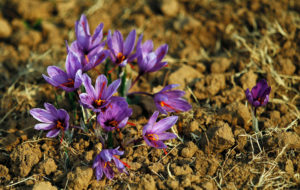
The plant grows on the southern coast of the Mediterranean Sea, in Spain, France, in Asian countries: in China, India, Japan, as well as in the Crimea, Dagestan. You cannot find saffron in the wild. Cultivation of the culture is widespread throughout the world, since saffron is a plant that benefits human health, as well as a spice with a bright unique taste.
The plant blooms for only 3 days, in spring or autumn, depending on the species. For the preparation of spices, flowers are harvested immediately after they are opened. The stigmas are then removed to dry and eventually spice. Drying takes no more than 20 minutes, after which the stigmas are immediately placed in sealed glass jars. So they do not have time to lose their properties. That is, it is the stigmas of saffron flowers that have medicinal properties that are beneficial to humans.
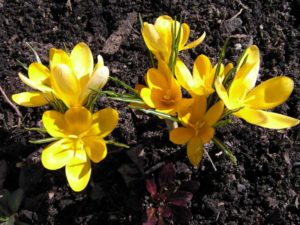
The production of saffron is an expensive process, as 3 stigmas are usually obtained from one flower. For 1 kg of spice, 150 thousand flowers must be processed. On average, 20 kg of spices are obtained from 1 hectare of land. Unfortunately, other parts - roots, leaves, saffron seeds - do not benefit humans.
The spice is sometimes called red gold due to its high cost. In Russia, the average price for 1 g of saffron is from 70 rubles.
Chemical composition and caloric content of saffron
Saffron is a fairly high-calorie spice: 310 calories are contained in 100 g of the product. But since less than 1 g of spice is used in cooking, its calories can be completely ignored - there will be no harm to those who lose weight from it.
The used / w / y ratio is as follows:
- proteins - 11.43 g;
- fats - 5.85 g;
- carbohydrates - 65.37 g;
- fiber - 3.9 g
The spice contains useful minerals:
- potassium - 1724 mg (per 100 g);
- magnesium - 264 mg;
- phosphorus - 252 mg;
- sodium - 148 mg;
- calcium - 111 mg;
- manganese - 28 mg;
- iron - 11 mg;
- selenium - 5 mg;
- zinc - 1 mg;
- iron - 0.33 mg.
Vitamins:
- C;
- A;
- B6;
- folic acid (vitamin B9);
- nicotinic acid (vitamin PP);
- thiamin (vitamin B1);
- riboflavin (vitamin B2).
Saffron contains an essential oil that contains antioxidants.
Since the spice is used in scanty quantities, it is not rational to count on it as a source of useful minerals and vitamins.
What is saffron good for?
The benefits of saffron for the human body are expressed primarily in the general strengthening effect. Beneficial properties are often used in traditional medicine, which will be discussed below.
The spice has the following effects on the body:
- calming;
- diuretic;
- choleretic;
- antispasmodic;
- weak pain reliever.
Those who regularly add spice to food in moderation note such positive changes as:
- activation of human mental activity;
- reduced sweating;
- improved appetite;
- strengthening of immunity;
- acceleration of metabolism;
- normalization of the digestion process.
The spice is especially useful for women. In particular, for problems with an irregular menstrual cycle. It increases libido, intensifies attempts during childbirth.
Indian medicine Ayurveda considers the spice useful to everyone, without exception.
What diseases does saffron treat?
It is difficult to argue with the medicinal properties of saffron, especially considering that it is added to the composition of some eye drops. Indeed, due to its properties, it helps the elderly to normalize visual impairment as a result of muscle degeneration or retinitis pigmentosa.
The benefits for the work of the cardiovascular and nervous systems are noted when using a fortifying tincture containing useful spices.
Thanks to the expectorant effect of the spice, they even treat coughs in children, respiratory diseases.
The benefits of saffron in cancer of the lungs, breast, pancreas, and some other tumors are being studied. For example, oil contains antioxidants that fight off pre-existing cancer cells or their appearance.
Can saffron be given to children
To avoid harm to children under 2 years old, and for some sources under 3 years old, it is not recommended to add saffron to food.
Even after the onset of 3 years of age, the addition of spices to baby food should be scanty, since overdose is dangerous even for an adult.
The spice has an effective expectorant property, so children are allowed to use it when coughing as an adjunct to the treatment prescribed by a doctor.
Is saffron allowed for pregnant and lactating women
It is better for pregnant women to refuse to add spices to food, as it can harm the change in the tone of the uterus. In the worst case, the result is a miscarriage and miscarriage. In the later stages, premature birth may begin.
There is no prohibition on the use of spices for nursing women: no specific benefits or harms for this condition have been found. In this case, the product must be carefully introduced into the diet, observing the child's reaction. If negative consequences are noticed, you should temporarily abandon the spice and check with a doctor whether the spice really caused them.
Traditional medicine recipes using saffron
The healing properties of saffron have long been known to folk medicine. Its scope is extremely wide: from the treatment of diseases of internal organs to the healing of wounds and boils.
It is used both externally in combination with other useful ingredients, and internally as an infusion or with tea. Taking saffron for medicinal purposes should be done with caution, as an overdose can be harmful.
For kidney stones
The medicinal benefit lies in cleansing the kidneys from the harm of stones: saffron promotes their crushing and elimination from the body.
Most often they are consumed with honey melted in a water bath. Reception is carried out in 1 tsp. 2 times a day before meals.
Saffron infusion is also useful. For cooking, take 1 tsp. spices, that is, about 5 threads and pour a glass of boiling water. After half an hour, filter the drink. To avoid harm, drink no more than 1 glass of infusion per day. The healing properties of saffron tincture do not end there: this recipe is also useful for the treatment of other diseases.
With a cold
First of all, the spice is used to prevent colds.
If a person is already sick, then tea with spices or in the form of a separate infusion improves overall well-being. The drink is able to reduce high fever, eliminate cough thanks to its expectorant properties.
Tea is especially effective in combination with cinnamon, ginger, which also have medicinal properties, helping with colds.
For diseases of the liver and circulatory system
In Asian countries, spice liver treatment is common. The benefits of taking saffron tea for the prevention of diseases have been noticed.
The drink also cleanses the circulatory system. It can be replaced with a tincture prepared according to the standard recipe.
For eye diseases
In official medicine, saffron is found in eye drops. It is also useful when taken orally, helping against eye diseases: both genetic in nature and those caused by aging. The disease does not completely disappear, but its development slows down.
The spice is used not only in the form of a tincture: the benefits of milk with saffron in the form of tea are known.
For headaches and insomnia
For severe headaches, lotions with saffron infusion are useful.
With mild pain, as well as in case of insomnia, taking spices inside helps:
- in the form of an infusion;
- together with honey;
- with warm milk.
Best taken one hour before bedtime due to saffron's hypnotic effects.
For leg cramps
The benefits of the spice are noted for cramps of the lower extremities.
For general effects on the body, you can take a tincture. To do this, pour 1 tbsp. l. stigmas with 1 cup boiling water. Let it brew. When cool, strain. Take 1 tbsp. l. tinctures 2 times a day.
You can also make an "ointment". For this purpose, 3 egg whites are mixed with a small amount of spice. Use immediately after preparation: storage of the mixture leads to the loss of its benefits.
Saffron tea to enhance potency in men
The beneficial properties of saffron for men are invaluable: it is able to increase libido not only in women, but also have a similar effect on the male body. Saffron is sometimes referred to as an aphrodisiac condiment.
To prepare a drink, mix 4 strands of spices and 1 tsp. black tea. The benefits of saffron tea are increased by adding 20 - 25 g of ginger and a pinch of black pepper. Pour the resulting mixture with a glass of water, boil in a water bath. Then strain.
In case of violation of the menstrual cycle
In Ayurveda, the beneficial properties of saffron for women are highly valued, in particular, for the regulation of disturbed menstruation.
Infusion of saffron helps to cause them in case of delays or, conversely, relieves the condition with prolonged and heavy menstruation, bringing them back to normal. Turmeric is also added to the infusion.
For thrush and painful periods
The spice is used as an antispasmodic to relieve pain during menstruation.
For thrush, along with the treatment prescribed by your doctor, you can try the following recipe. Mix in 1 tsp. saffron and borax herbs. Pour 0.5 liters of boiling water. Let it brew for 15 minutes, then strain. The resulting healthy drink should be consumed in half a glass every morning.
To stimulate contractions
Pregnant women are prohibited from using the spice, as it causes premature contractions. However, if labor has already begun, then this spice makes the process easier.
It is enough to add a few strands of saffron to hot milk and drink. It is useful to do this at the very beginning of the process or with weak contractions.
From cystitis
The spice has a pronounced diuretic property, therefore it is used to treat cystitis, urolithiasis and other diseases of the urinary tract.
For treatment, take 1 tbsp. l. infusion of saffron before each meal, but no more than 3 times a day.
Treatment of boils and purulent wounds
It is recommended to wash boils and purulent wounds with infusion, to get tangible benefits - do it regularly.
For difficult-to-heal skin lesions with the same infusion, it is useful to make lotions or wet dressings.
The use of saffron in home cosmetology
The benefits of saffron for women are not limited to the kitchen. For example, the benefits of a mask with saffron for the face are known: it promotes external rejuvenation, helps to cope with acne and age spots. The spice is also used in hair mask recipes to give curls a shine and healthy look.
Purifying face mask
Facial saffron is also useful as a cleansing mask.
To prepare it you will need:
- ¼ h. L. saffron powder;
- 2 tbsp. l. any cosmetic clay suitable for a specific skin type;
- water in such an amount that the mixture is similar in consistency to sour cream;
- add 1 - 2 drops of lavender essential oil if desired.
The resulting mask is applied to the face and kept for 10 - 15 minutes: until the clay begins to dry a little. Then gently wash off with water. Don't rub your face.
Acne face mask
This mask requires:
- 1 tbsp. l. natural yogurt without any additives;
- ½ tsp lemon juice;
- 3-4 strands of saffron.
The resulting mixture is applied to the face for 10 minutes, then washed off with cool water. The benefits are visible after the first application.
Hair Mask
Saffron is often used in hair products. In home recipes, less often, as it can often give a coloring effect.
One of the most popular is the mask with henna, since the latter itself is good for the hair. Depending on the length of the curls, the proportions vary within the following limits:
- 1 - 2 packs of henna;
- 3 - 4 tsp saffron.
The mixture is applied to the entire hair length for 30 minutes. Then rinse off using shampoo and hair conditioner.
What dishes are saffron added to
The spice adds spice to the food. Therefore, it is used for cooking:
- meat dishes;
- fish dishes;
- seafood;
- pilaf;
- creams, sauces;
- desserts;
- baked goods (buns, muffins, cookies, etc.);
- even drinks.
At the same time, seasoning is added to baking at the stage of kneading the dough, and to hot dishes - 2 - 5 minutes before readiness.
The taste and smell of saffron is not immediately revealed, so the pastries are more aromatic the next day. For hot meals, it is helpful to prepare the spice in advance. First, the stigmas are fried in a dry frying pan, then grind them and mix with a tablespoon of milk or water.Only after that is added to the dish. So the aroma becomes more intense, although it is well felt without preliminary preparation.
The amount of spice depends on the specific recipe, but in any case it is measured in pinches or a few stigmas. It is important not to overdo it, otherwise the dish will taste bitter: a large amount of saffron can be harmful to health.
Saffron oil properties and uses
Saffron essential oil has an intense scent. Its useful properties have been found:
- antispasmodic;
- anti-aging;
- tonic;
- anti-inflammatory;
- strengthening;
- calming.
Saffron oil is used.
- For medicinal purposes. For example, 2 drops of essential oil and 2 - 3 tbsp. l. base rubbed to treat rheumatism.
- In cosmetology. The benefits of saffron essential oil for the face are especially noted. The skin color evens out: it begins to shine, as it were, from within.
- For flavoring food: pre-mix the spice with any base oil.
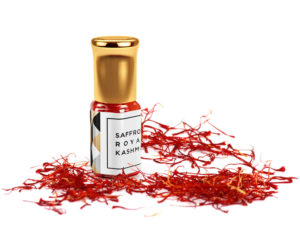
Saffron harm and contraindications
The benefits and harms of saffron for the body depend on the amount of spice eaten with food. If this is a small volume, then it only benefits a person. A large portion is likely to be harmful. Sometimes saffron can even cause death.
The negative consequence is most likely to be poisoning, which is accompanied by symptoms:
- diarrhea;
- vomiting;
- nosebleeds;
- yellowing of the skin or eyes.
If at least one of them is found, you must immediately call an ambulance.
For a healthy adult, 10 g is considered a lethal amount. For children, the elderly and people with poor health, this threshold is reduced.
The spice is contraindicated:
- people with bipolar disorder;
- if you have an allergy or intolerance to the product (therefore, use a small amount for the first time);
- with hypertension;
- if you have had a stroke or heart attack before, use with caution.
To avoid harm to the body, you need to monitor the expiration date of saffron, the dosage in the recipe, as well as your own health.
How saffron differs from turmeric
Many people are mistaken in considering these spices to be identical. The error is caused by the fact that both spices have the same properties: they color the food, are somewhat similar in color and taste. In addition, in their homeland, in India, turmeric is called Indian saffron. This is where the similarity of the products ends. The health benefits and harms of saffron are not comparable to those of turmeric.
Saffron is an elite spice. He is painstakingly assembled and selected, as described above.
The whole root system of the plant is used to produce turmeric, not just the stigma of the flowers. Therefore, the spice is easier to obtain, and its price is much lower. Turmeric is sold in bulk and saffron is sold in 2-4 g each.
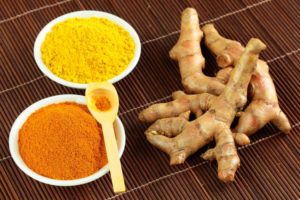
Since the cost of saffron is high, the sale of powdered spices is often fooled into offering cheaper spices. Specifically turmeric. They are similar in color, but turmeric is closer to a yellow or orange hue, and saffron is closer to a rich red and even brown.
How to choose and store saffron
In shops and markets, stigmas or ground powder are sold.
Since the powder is often counterfeited, so in order to be confident in the benefits of saffron, it is better to buy stigmas and grind them yourself just before cooking.
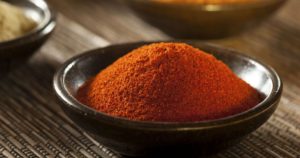
Similar to long strings, saffron stigmas fit this description:
- soft;
- saturated dark red, sometimes closer to brown or interspersed with yellow threads;
- are sold for a high cost (if low, then there is a high probability that the composition was mixed with cheap spices).
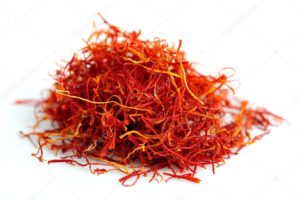
In order not to lose its beneficial properties, saffron should be stored for no more than 2 years in a sealed package in a dry form. Place the container or package in a dark place.
Conclusion
The benefits and harms of saffron are regulated by the correct dosage of this product: the less amount of spice in a food, the less likely it is to harm your body. But even a few strands of spice help to heal diseases, increase the effectiveness of home cosmetic procedures. The most important thing is to buy a natural product without confusing it with other spices.

